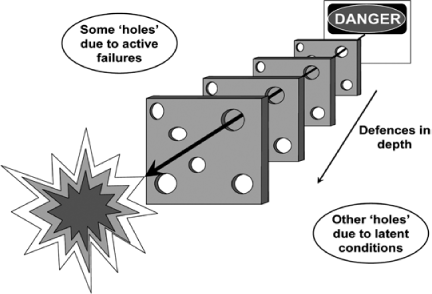Rhona Flin Paul OConnor - Safety at the Sharp End
Here you can read online Rhona Flin Paul OConnor - Safety at the Sharp End full text of the book (entire story) in english for free. Download pdf and epub, get meaning, cover and reviews about this ebook. year: 2008, publisher: Ashgate Publishing Limited, genre: Religion. Description of the work, (preface) as well as reviews are available. Best literature library LitArk.com created for fans of good reading and offers a wide selection of genres:
Romance novel
Science fiction
Adventure
Detective
Science
History
Home and family
Prose
Art
Politics
Computer
Non-fiction
Religion
Business
Children
Humor
Choose a favorite category and find really read worthwhile books. Enjoy immersion in the world of imagination, feel the emotions of the characters or learn something new for yourself, make an fascinating discovery.

- Book:Safety at the Sharp End
- Author:
- Publisher:Ashgate Publishing Limited
- Genre:
- Year:2008
- Rating:3 / 5
- Favourites:Add to favourites
- Your mark:
- 60
- 1
- 2
- 3
- 4
- 5
Safety at the Sharp End: summary, description and annotation
We offer to read an annotation, description, summary or preface (depends on what the author of the book "Safety at the Sharp End" wrote himself). If you haven't found the necessary information about the book — write in the comments, we will try to find it.
Safety at the Sharp End — read online for free the complete book (whole text) full work
Below is the text of the book, divided by pages. System saving the place of the last page read, allows you to conveniently read the book "Safety at the Sharp End" online for free, without having to search again every time where you left off. Put a bookmark, and you can go to the page where you finished reading at any time.
Font size:
Interval:
Bookmark:
SAFETY AT THE SHARP END
a Guide to non-technical Skills
RHONA FLIN, PAUL OCONNOR and MARGARET CRICHTON
ASHGATE
Rhona Flin, Paul OConnor and Margaret Crichton 2008
All rights reserved. No part of this publication may be reproduced, stored in a retrieval system or transmitted in any form or by any means, electronic, mechanical, photocopying, recording or otherwise without the prior permission of the publisher.
Rhona Flin, Paul OConnor and Margaret Crichton have asserted their moral right under the Copyright, Designs and Patents Act, 1988, to be identified as the authors of this work.
Published by
Ashgate Publishing Limited
Gower House
Croft Road
Aldershot
Hampshire GU11 3HR
England
Ashgate Publishing Company
Suite 420
101 Cherry Street
Burlington, VT 05401-4405
USA
Ashgate website: http://www.ashgate.com
British Library Cataloguing in Publication Data
Flin, Rhona H.
Safety at the sharp end : a guide to non-technical skills
1. Industrial safety 2. Safety education 3. Safety education, industrial 4. Accidents - Prevention 5. Errors -Prevention
I. Title II. OConnor, Paul III. Crichton, Margaret
363.11
Library of Congress Cataloging-in-Publication Data
Flin, Rhona H.
Safety at the sharp end : a guide to non-technical skills / by Rhona Flin, Paul OConnor, and Margaret Crichton.
p. cm.
Includes bibliographical references and index.
ISBN 978-0-7546-4598-6 -- ISBN 978-0-7546-4600-6 (pbk)
1. Safety education, Industrial. I. OConnor, Paul. II. Crichton, Margaret, Dr. III. Title.
T55.2.F55 2007
658.382--dc22
2007021822
ISBN 978-0-7546-4598-6 (Hbk)
ISBN 978-0-7546-4600-6 (Pbk)
ISBN 978-1-4724-2400-6 (ebk-PDF)
ISBN 978-1-4724-2401-3 (ebk-ePUB)
We would like to thank the following people for providing material or commenting on draft chapters: Bob Hahn, Matthew Hilscher, Terry Kelly, Bill Little, Mike Lodge, Jean McLeish, Richard Miller, Ed Naggiar, Simon Paterson-Brown, Tanja Pullwitt, Cameron Ramsay, Tom Reader, Dick Stark, John Tse, George Youngson, and Steven Yule.
In particular, our special thanks go to John Thorogood for his full and frank but always constructive comments on a number of chapters.
We would also like to acknowledge the contribution of Guy Loft and John Hindley of Ashgate for their support and advice, and Gemma Lowle for her help with editing and production.
Any remaining errors are our own and we would be grateful to hear from any readers who can provide corrections.
Introduction
When things go wrong in high-risk organisations, the consequences can result in damage to humans, equipment and the environment. Significant levels of protection and redundancy are built into modern technical systems, but as the hardware and software have become increasingly reliable, the human contribution to accidents has become ever more apparent. Analyses in a number of industrial sectors have indicated that up to 80% of accident causes can be attributed to human factors (Helmreich, 2000; Reason, 1990; Wagenaar and Groenweg, 1987). This means that managers also need to understand the human dimension to their operations, especially the behaviour of those working on safety-critical tasks the sharp end of an organisation. Psychologists have long been interested in the factors that enhance workers performance and minimise error rates (Munsterberg, 1913). We know that human error cannot be eliminated, but efforts can be made to minimise, catch and mitigate errors by ensuring that people have appropriate non-technical skills to cope with the risks and demands of their work.
Non-technical skills are the cognitive and social skills that complement workers technical skills (Flin et al., 2003). The definition of non-technical skills used to underpin this book is the cognitive, social and personal resource skills that complement technical skills, and contribute to safe and efficient task performance. They are not new or mysterious skills but are essentially what the best practitioners do in order to achieve consistently high performance and what the rest of us do on a good day. This book describes the basic non-technical skills and explains why they are important for safe and efficient performance in a range of high-risk work settings from industry, health care, military and emergency services.
The seven skills we discuss are:
situation awareness (attention to the work environment)
decision-making
communication
teamwork
leadership
managing stress
coping with fatigue.
This skills approach provides a set of established constructs and a common vocabulary for learning about the important behaviours that influence safe and efficient task execution. Methods of identifying, training and assessing key non-technical skills for particular occupations are outlined in the chapters to follow. The skills listed above are required across a range of settings. Much of the background material is drawn from the aviation industry but our aim is to demonstrate why these nontechnical skills are critical for many different tasks, from operating a control room on a power plant, to operating on a surgical patient. Human behaviour is remarkably similar across all kinds of workplaces.
Before examining the non-technical skills, it should be emphasised that this focus on workers behaviours is only one component of an effective safety management strategy. Organisational safety is influenced by regulatory and commercial pressures, the working environment and management demands. So, while this book concentrates on the skills of those operating the system, it is acknowledged that their behaviour is influenced by the conditions they work in and by the behaviours of others, particularly those in managerial positions (Flin, 2003; Hopkins, 2000).
As Reason (1997) illustrated in his Swiss Cheese model (see ), accidents are usually caused by a sequence of flaws in an organisations defences. These can be attributed to a combination of errors and violations by the operational staff (active failures) and the latent unsafe conditions (resident pathogens) in the work system that are created by managers, designers, engineers and others.

Figure 1.1 An accident trajectory passing through corresponding holes in the layers of organizational defences (Reason, 1997, Fig 1.5)
Reprinted with permission of Ashgate.
The front line personnel represent the last line of protection of the systems defences. They are not only responsible for the active failures that can contribute to losses and injuries, but more importantly, they regularly catch and correct their own and others errors. Helmreich et al.s (2003) observations on aircraft flight decks showed that airline pilots make about two errors per flight segment, but that most of these are caught and corrected by the air crew themselves. Moreover, front-line staff can also recognise and remedy technical malfunctions and can cope with a wide variety of risky conditions. Therefore, while human error is inevitable and pervasive, as Reason (1997) pointed out, humans can also be heroes by providing the essential resilience and expertise to enable the smooth operation of imperfect technical systems in threatening environments.
We begin by describing how a series of puzzling aircraft accidents in the 1970s led to the recognition of the importance of non-technical skills in aviation. This is followed by an account of how these skills have since become a focus of attention in other work settings.
Next pageFont size:
Interval:
Bookmark:
Similar books «Safety at the Sharp End»
Look at similar books to Safety at the Sharp End. We have selected literature similar in name and meaning in the hope of providing readers with more options to find new, interesting, not yet read works.
Discussion, reviews of the book Safety at the Sharp End and just readers' own opinions. Leave your comments, write what you think about the work, its meaning or the main characters. Specify what exactly you liked and what you didn't like, and why you think so.








